Chris25
Member
Hi all,
My first post here and unfortunately it has to be about the outbreak of algae I'm currently having!
I've had my tank setup for around 8 months now, with fish in for around 6 months and up until around 2 weeks ago, virtually algae free!
It's a Rio 180L.
I have 4 T8 30W bulbs (0.66W/litre) on for 9 hours, from 11am until 8pm.
I have pressurised Co2 with inline diffuser, 2 drop checkers (1 each end) showing this in the green region. I have slightly increased the co2 to possibly try and help with the algae. Comes on 1 hour before lights and goes off one hour before lights too.
I am running a fluval 406 with a spray bar covering around 80% of the tank, the intake is in the far back left hand corner with the spray bar back top right hand corner, opposite end of tank.
For ferts I am using EI and dosing Micro/Macro alternate days with a rest day Wednesday and water changes Thursday.
Heating is inline Hydor ETH 300W kept at 30C.
Water change 40-50% weekly, using HMA water.
Substrate: Eco-Complete
Inhabitants:
~90 cardinal tetra
~10 otos
5 Bronze cory
~40 Red Cherry Shrimp (I added these Sunday to hopefully help with the algae outbreak. Can move them out if needs be to holding tank)
Assassin Snails (Started with 8, but reckon there's at least 40 now, mainly small babies)
~50 MTS
Fish get fed daily (Tetra Prima Mini) and all gets eaten within seconds.
Occasional algae wafer for otos and corys
I seem to have about 3 or 4 (probably more) different types of algae. I've attached pictures below.
I'm going to have a big cut back tomorrow removing the leaves covered in algae and adjust the spray bar to angle slightly more up to agitate the surface even more, but this seems counter productive to the co2 dosing?
Could anyone help with the best way to combat the different types of algae?
From a distance it looks great!
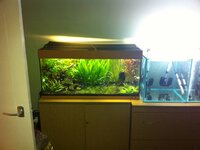
But on closer inspection...
Aquarium Algae ID (updated May6th '10 Surface Skum)
Used this to try and identify where I can,
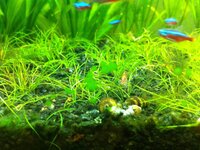
Circular algae on the glass, green spot algae or green dust algae?
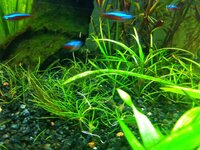
Not the best picture and hard to see but main strand in middle of picture has algae growing from it, Not sure which algae this is?
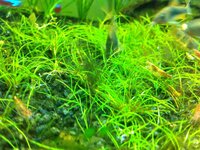
Looks to be some kind of hair algae growing amongst the dwarf hairgrass. Really want this plant to carpet everywhere but it just doesn't seem to want to in my setup. Any tips on this would be greatly appreciated too. RCS hopefully helping out...
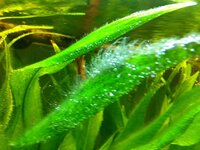
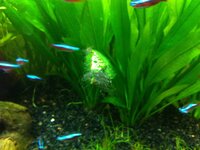
These two, again some kind of hair/thread algae growing on the leaves. These leaves will be removed! Stag horn algae maybe?
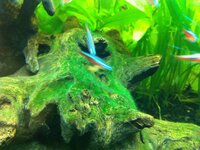
This algae I actually dont mind on the wood and think it looks good. (If it would only stay on the wood) Green beard algae?
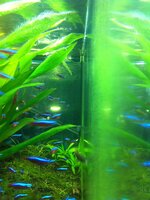
This is down the inside of the glass, small hairy algae growing on the glass! Green beard again?
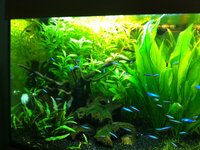
The plant in the back corner doesn't reduce flow as the outpipe is to the right of this but will trim this down so it is an inch or two below the surface.
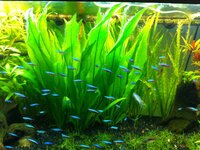
The green leafy plant in the middle I think had got too tall and is reducing flow which could be causing some issues?
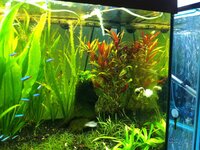
Love this red plant in the corner, but that too is covered in algae on the top of the leaves.
My initial thoughts are,
Cut away leaves with algae
Increase surface agitation by angling spray bar further upwards
Reduce lighting, turn one or two of the lights off
Reduce lighting time from 9 hours to 6
Start co2 injection 2 hours before lights come on
Use razor blade on glass and remove algae and suck this away at same time during water change
Increase co2 levels to more of a green/ slightly yellow drop check colour instead of firmly in green
I currently plan to do all of this at once and if that doesn't work try a blackout...
Are my steps above correct to deal with this? Should I do all at once or try changing one thing at a time?
If you need any more information just ask.
Will check the Ammonia, Nitrite, Nitrate and Ph levels tomorrow.
Thanks in advance!
Chris
My first post here and unfortunately it has to be about the outbreak of algae I'm currently having!
I've had my tank setup for around 8 months now, with fish in for around 6 months and up until around 2 weeks ago, virtually algae free!
It's a Rio 180L.
I have 4 T8 30W bulbs (0.66W/litre) on for 9 hours, from 11am until 8pm.
I have pressurised Co2 with inline diffuser, 2 drop checkers (1 each end) showing this in the green region. I have slightly increased the co2 to possibly try and help with the algae. Comes on 1 hour before lights and goes off one hour before lights too.
I am running a fluval 406 with a spray bar covering around 80% of the tank, the intake is in the far back left hand corner with the spray bar back top right hand corner, opposite end of tank.
For ferts I am using EI and dosing Micro/Macro alternate days with a rest day Wednesday and water changes Thursday.
Heating is inline Hydor ETH 300W kept at 30C.
Water change 40-50% weekly, using HMA water.
Substrate: Eco-Complete
Inhabitants:
~90 cardinal tetra
~10 otos
5 Bronze cory
~40 Red Cherry Shrimp (I added these Sunday to hopefully help with the algae outbreak. Can move them out if needs be to holding tank)
Assassin Snails (Started with 8, but reckon there's at least 40 now, mainly small babies)
~50 MTS
Fish get fed daily (Tetra Prima Mini) and all gets eaten within seconds.
Occasional algae wafer for otos and corys
I seem to have about 3 or 4 (probably more) different types of algae. I've attached pictures below.
I'm going to have a big cut back tomorrow removing the leaves covered in algae and adjust the spray bar to angle slightly more up to agitate the surface even more, but this seems counter productive to the co2 dosing?
Could anyone help with the best way to combat the different types of algae?
From a distance it looks great!

But on closer inspection...
Aquarium Algae ID (updated May6th '10 Surface Skum)
Used this to try and identify where I can,

Circular algae on the glass, green spot algae or green dust algae?

Not the best picture and hard to see but main strand in middle of picture has algae growing from it, Not sure which algae this is?

Looks to be some kind of hair algae growing amongst the dwarf hairgrass. Really want this plant to carpet everywhere but it just doesn't seem to want to in my setup. Any tips on this would be greatly appreciated too. RCS hopefully helping out...


These two, again some kind of hair/thread algae growing on the leaves. These leaves will be removed! Stag horn algae maybe?

This algae I actually dont mind on the wood and think it looks good. (If it would only stay on the wood) Green beard algae?

This is down the inside of the glass, small hairy algae growing on the glass! Green beard again?

The plant in the back corner doesn't reduce flow as the outpipe is to the right of this but will trim this down so it is an inch or two below the surface.

The green leafy plant in the middle I think had got too tall and is reducing flow which could be causing some issues?

Love this red plant in the corner, but that too is covered in algae on the top of the leaves.
My initial thoughts are,
Cut away leaves with algae
Increase surface agitation by angling spray bar further upwards
Reduce lighting, turn one or two of the lights off
Reduce lighting time from 9 hours to 6
Start co2 injection 2 hours before lights come on
Use razor blade on glass and remove algae and suck this away at same time during water change
Increase co2 levels to more of a green/ slightly yellow drop check colour instead of firmly in green
I currently plan to do all of this at once and if that doesn't work try a blackout...
Are my steps above correct to deal with this? Should I do all at once or try changing one thing at a time?
If you need any more information just ask.
Will check the Ammonia, Nitrite, Nitrate and Ph levels tomorrow.
Thanks in advance!
Chris


